| Entries |
| C |
|
Community Organizing
|

|
In his latter years Alinsky assumed the role of elder statesman of organizing, sparking a new generation of organizers, who in some cases substantially reworked his tactical program. Chicago has remained a center of community organizing. During the 1970s, one of the nation's most important training centers for organizers, the Midwest Academy, was founded in Chicago. In the early years of that decade, an ambitious organizing effort known as the Citizens Action Program (CAP—originally the Campaign Against Pollution) forged a new model of Alinsky-style organizing. CAP sought to mobilize a citywide constituency by focusing on an array of public policy issues—including air pollution, expressway plans, and mortgage lending practices—and financed its operations through member dues. Though CAP collapsed in the mid-1970s, its agenda-setting, coalition-building, and fund-raising strategies were adopted by many subsequent organizing campaigns.
Since the 1970s Chicago has been the site of numerous organizing campaigns. Often groups have responded to neighborhood demographic or economic changes. Many contemporary organizing efforts have substituted a community development emphasis for Alinsky's more directly confrontational tactics, thus seeking to upgrade neighborhood conditions through indigenous efforts or by working with government or other institutions outside the neighborhood.
The Encyclopedia of Chicago © 2004 The Newberry Library. All Rights Reserved. Portions are copyrighted by other institutions and individuals. Additional information on copyright and permissions.